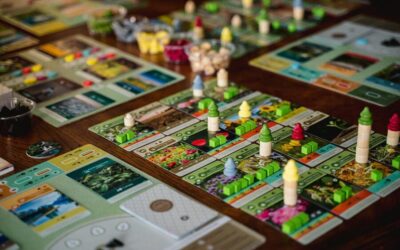Community/Social
Social Bonds and Community Actions Reduce Emissions and Increase Resilience
If people work together to share news and resources with their neighbors, they can travel less and consume less, reducing their carbon footprint while creating a friendlier, safer, stronger community. Here are some ways you and your community can act.
Steps: Social/Community
 Join a climate action group
Join a climate action group

Create a green team at school

Start or join a community garden
LEARN
Resource-sharing communities are powerful
We can reduce our carbon footprints by sharing resources with our communities, whether they are our block, our neighborhood or town, or even online. By acting together, communities can create broader change and make bigger differences than individuals can.
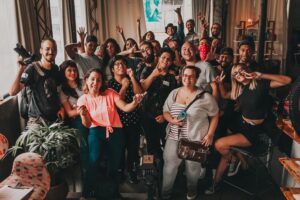
Photo by Matheus Bertelli via Pixels.com
Unfortunately, far too many people, especially in the more consumer-focused countries, don’t interact with their communities in the ways we used to (Pew Research Center). These societies have been “atomized” by marketing and technology that has encouraged and enticed people to stay home instead of getting together with neighbors.
Another contributing factor is the concept in some cultures of needing to be self-reliant financially, in housing, in raising our families, and more. Approaching others for help when we really need it can seem risky. For one thing, our neighbors may not know us very well, and if we ask for help, they might make inaccurate judgements about our ability to handle our own problems. At the same time, in many consumer-driven countries, we’re taught that if we don’t know how to fix something, we should pay someone to do it, and we’re expected to earn enough to afford to do so. Despite it being harder to afford things nowadays, asking people to help simply because they’re neighbors or even if they’re friends just seems to be out of the question or too great an imposition to cause them.
Let’s get acquainted and share!
We don’t have to do everything by ourselves, and we can share some of what we have so that each home doesn’t have to buy every gadget. The focus on this page is on neighborhood-level communities, for which
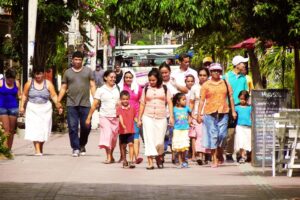
Photo by Q. K. via Pixabay.com
many studies have been done showing that local communities that are better connected than others are more resilient when disasters arrive. There are lots of ideas we can use to help bring communities together and make them stronger – more adaptable to climate change. At the same time, if we’re sharing resources, we won’t consume as much, and we’ll reduce the CO2 emissions associated with the extraction, processing, and transportation of everything from raw materials to finished products that we bring home or have shipped to our homes.
First, we have to take steps to get to know each other. In order to get enough people on board to make the kind of change we need to effectively lower our global emissions – and adapt to climate change, you need to find a way to build your community and make it more comfortable with interdependence before any of that is possible. However, the current atmosphere in some places in the U.S. and some other regions can make initial, important conversations seem impossible in some cases; as soon as we mention some of the issues that are most important to us, we give away which camp we’re in, and conversations are shut down. Nevertheless, neighbors will work with neighbors toward specific, common goals. There are usually smaller communities within any locality, such as churches, parents’ groups, and gardening groups. And though people may have different political opinions, many believe in thrift, and the ideas you’ll find in this section help communities to save money.
Still, in order to know what else is possible, we need to listen to each other, and we need to make it obvious
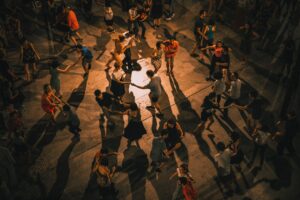
Photo by Ardian Lumi via Unsplash.com
that we’re listening and that we are appreciative of the needs of another person when expressed. We can use some of the information we learn from each other to discover common goals so that we can work towards the ideas we all agree on, and try to expand our agreements.
Inspiring Community Initiatives
Remember that as communities learn to share more resources, they can consume less, which in turn can reduce the greenhouse gas emissions related to their consumption. At the same time, that resilience can help them withstand the challenges that global warming will bring.
But What Does This Have to Do With Climate Change?
It’s related in a few ways:
- You and your community will care more about any pollution created by a local business than owners who don’t live in the area will, so you’re more likely to keep pollution to a minimum.
- The stronger the connections between you and your various communities, the more likely it is that you’ll be able to withstand future climate shocks.
- Because co-ops and collectives treat their members more fairly, co-op members have less stress to deal with, as a result of the pay and benefits they receive and the relative satisfaction of working at a job you like. This means they’re healthier and better able to handle challenges.
Types of Resource-Sharing Communities
Tool Libraries, Libraries of Things, Repair Cafes
One great way to create links among community members is to share the things you don’t often need and to help each other repair what is broken instead of buying new, which leads to lower emissions associated with the extraction, processing, and transportation of goods. Here are a few approaches that people have been using already; what’s a good fit for your community?
- Tool Libraries: We can share some of what we have so that each home doesn’t have to buy every gadget. Tool libraries work just like regular libraries, the main difference is simply that you’re loaning tools, not books. What to know more? Climate Steps has an article describing the benefits of tool libraries, but also look here.
- Libraries of things: Why stop at tools? Many communities have opened “Libraries of Things,” often in their original public libraries, where you can borrow anything they have space for.
Instead of trying to sell things at garage sales or donating them to large organizations (which, however, still can benefit others) , neighbors share their extra stuff with the rest of the community. You can learn more here.
- Repair Cafes: We’re getting used to the idea of throwing broken things away. It wasn’t always like that. Many things are repairable; all we need is knowledge and the right tools. More and more communities are opening repair cafes. They usually don’t have regular hours; according to Repair Together, the network of Repair Cafés in Brussels and Wallonia, repair cafes are regular events, usually held once a month in many municipalities. You can learn more about them here, consider options by visiting here, or see if there’s one near you.
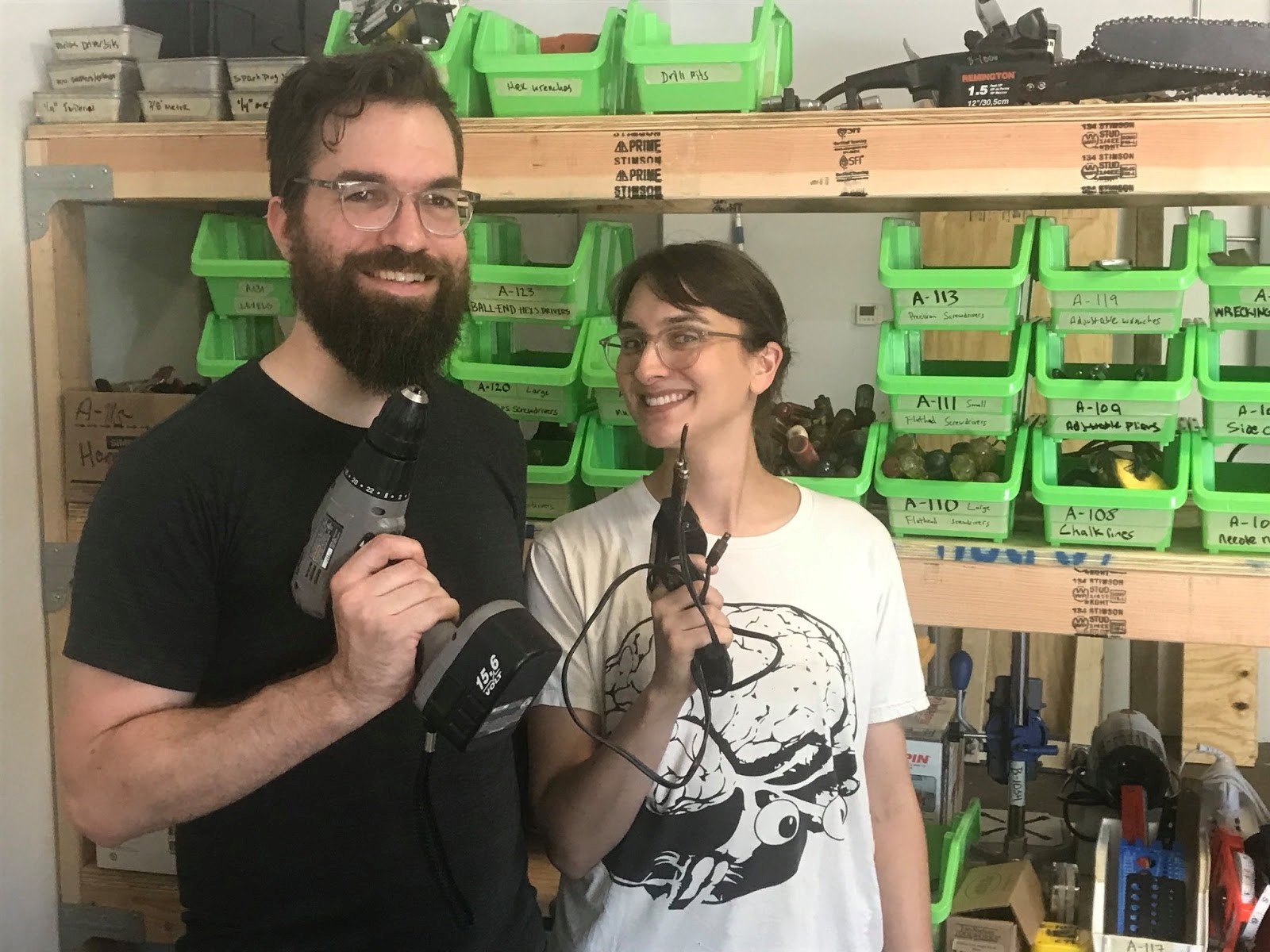
Jim Benton and Tessa Vierk, Founders of the Chicago Tool Library, Courtesy of the Chicago Tool Library

Cooperatives and Collectives
Cooperatives and collectives fit many definitions. Once you begin to get to know people in your various communities, new possibilities arise to share all kinds of things with them, including work and other types of common projects.
- Cooperatives: According to the Merriam-Webster dictionary, cooperatives (co-ops) are “an enterprise or organization owned by and operated for the benefit of those using its services.” They’re better for communities than chain stores, for a few specific reasons:
-
- A chain store, despite what the corporation may say, has no strong commitment to keeping jobs in your neighborhood. A co-op does. If you’re a worker, wouldn’t you rather work close to home? If you’re a customer, wouldn’t you prefer to have some say in the quality of the goods and services available in your area?
- At the same time, the only incentive corporations have to treat their employees well is the possibility that employees could quit and work somewhere else. If corporate leaders join a local chamber of commerce and agree to pay everyone poorly, it will be hard to find a good-paying job. But you and your neighbors would look at employee pay and benefits differently, more fairly. Are you going to pay everyone $1000 an hour? No, the business would fail. Are you going to pay everyone the current minimum wage? Probably not, especially if you’re in a country where the minimum is really low. For example, there’s no state in the U.S where a parent can afford a two-bedroom apartment on full-time minimum wage work. What can the business afford? You and your business partners decide.
- Also, outside of the money paid to chain-store employees, most of the money generated by a corporate business leaves the neighborhood. This is important, because we need money to exchange value. Just because you don’t have any currency doesn’t mean you don’t have anything to exchange, but when no one has currency, it’s hard to do anything other than trade goods (Other options will be discussed in a section on community finance), and trading isn’t as flexible as the kind of exchanges we can make with currency. But if everyone who works locally spends their money locally, there’s more cash in the local economy, and it’s easier to exchange value. Find out more about how cooperatives keep money local here and about cooperatives in general here.

Toy Exchanges
How quickly kids outgrow toys(!), and why couldn’t another kid get some use of that toy? Many people have learned to share toys by having “Toy Exchanges,” cutting the emissions caused by continually buying new toys. Want to give it a try? Learn more.
Transition Movement
According to the Rapid Transition Alliance:
“The Transition Network began in 2006 in the small rural UK town of Totnes, Devon. It was initially a response to the twin threats of climate change and peak oil – what happens when global oil production peaks, plateaus and begins a long decline – and grew rapidly to become a global movement.”
“To begin with, the approach was focused on plans for ‘energy descent’ paths. Since then, it’s remit has become broader. But it remains all about communities stepping up to address the big challenges they face by taking action locally. In practice, this often means reclaiming the town’s economy, sparking entrepreneurship, re-imagining work, re-skilling and weaving webs of connection and support that keep resources in the towns and villages where it is created. Some places may focus on the local food, others on generating renewable energy, others rethinking local transport networks. Others might work on all these things and more.”
Look here to learn more about where transition towns have been and where they’re going.
Community Schools
Are you sensing a trend here, that as people get to know their neighbors better, they have the option of taking control over more aspects of life in their communities? Why not include schools? Some communities are already getting very involved in their schools, especially in New York City. They’re moving away from the heavy emphasis on standardized testing and into a “whole child approach” to education, looking after all of each students’ needs to ensure that they thrive. According to Yes! Magazine, “Each community school forms an alliance with a community-based organization that addresses its unique needs,” and. Will this approach work for your community? Check it out.
Community Energy
Another example of neighbors taking control of their lives is community energy, but this is more complicated than some of the other examples in this section, and it will be covered more in the Energy section. However, just to give you an idea, community energy is the process of neighbors deciding for themselves where they want their energy to come from (fossil fuels or renewables), how much of it they need, and how to make sure they have it when they need it. It’s certainly a great idea to make the switch from fossil fuels to renewables en masse, but you’ll want to have some experience working with your neighbors towards common goals before you take a shot at ideas like switching the whole community over to renewable energy. That doesn’t mean it’s not doable though. Learn more in our Energy section.
Examples of Communities Fighting Climate Change
Want more ideas about how to make your community more eco-friendly and climate-shock resistant? Here are some examples of communities working together to make a difference. Read on!

More Community Resources
Social/Community Articles
Let it Shine: Creative Ways to Use Solar Energy for Your Property
Image source: Deposit photos Guest author: Annie Button, UK Earth Hour 2024, on the 23rd March at 8:30 pm, is an important moment to set aside to reflect on our collective use of energy and how it impacts our environment. With its symbolic ‘lights off’ message, it...
How to Create an Impactful Ripple Effect through Effective Communication
As the world continues to warm, we must take whatever steps we can to slow down and then stop that process. And although we as individuals can definitely take worthwhile steps, we can achieve greater success if more of us participate. Luckily, we can influence other...
Better access to fresh, local food helps your community fight climate change
A wonderful, essential concept to build your community around is food. There are three main areas in which we can do so. First, by working with our neighbors to improve our community’s access to local, fresh food, we can spend more time in healthy environments while...
Our Games Resource Page has been updated and expanded!
Good news, Climate Steppers! We have updated and greatly expanded our Games Resource Page with more climate action and environmental games, with some help from Wikipedia (more below). The games we’ve chosen educate players about the science of climate change, the...
Pollinating Ideas and Planting their Seeds
We are in the first week of June and the global atmospheric CO2 level is 424.44 ppm, as compared to 420.69 ppm a year ago. When I was born in 1954, the average was 313.20 ppm. For the past several weeks, there've been statements from scientists at the United...
Videos About Climate Change and Community
Credits
Contributors: Mark Stewart, Annette Olson
Extra photo credits:
Header: Catherine Cordasco
- Protest: Photo by Green Neighbors DC member, 2017
- Repair cafe: Photo by John Wackman
- All are welcome sign: Photo by Katie Moum via Unsplash.com
More Resources:



